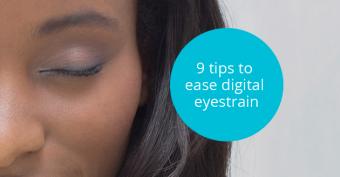Wednesday Wellness Word
Oh, our aching eyes! Throughout the day, many of us are busy staring at computers, tablets and phone screens. We may get a lot of work done. But there can be other results too: blurry vision, dry eyes, headaches and other symptoms of digital eyestrain.
Check out these tips for seeing better and more comfortably:
1. Keep your distance: When you’re using a computer or laptop, sit about 25 to 28 inches from the monitor. Position the screen so that you’re gazing slightly downward at it. You want to be able to easily read the screen while holding your head and upper body upright.
2. Beware of glare: Bright lights or sunlight can reflect off screens, adding to eyestrain. If you can’t avoid a window, close the drapes or blinds. Turn off or dim aggravating lights. Adding antiglare filters may also help. You can get them for screens of all kinds.
3. Control the contrast: If your screen itself is the brightest light in the room, your eyes must work harder to see. Help them out by increasing the surrounding light — without adding glare to the screen. You can also adjust the contrast on your screen for visibility and comfort, without increasing the brightness.
4. Blink! We usually blink about 15 times per minute. But when we use our digital devices, we tend to cut our blinks in half. Why does that matter? Because blinking helps keep our eyes moist. Try posting a note that says “Blink!” on your screen as a reminder.
5. Take 20: Give your eyes a rest by following the 20-20-20 rule. After 20 minutes of screen time, take 20 seconds to look at something 20 feet away. And if two hours have gone by? Give your eyes — and your brain — a brief visual vacation. Take a quick walk. Or put on some mellow music and close your eyelids.
6. Go with glasses: Hours of screen time can dry and irritate eyes. So can wearing contact lenses nonstop. If you have glasses, relying on them for some of your digital duties may help.
7. Put your papers on hold: Do you often need to reference paperwork while looking at your screen? Use a document holder so papers aren’t lying on your workstation. Your eyes can move from screen to papers and back again without having to refocus. Your neck and shoulders may thank you too!
8. Eat eye-specially good foods: Foods high in omega-3 fatty acids, such as salmon, walnuts, flax and chia seeds, may help reduce dry, irritated eyes. Fruits and veggies, particularly dark leafy greens, are always good choices for overall eye health.
9. Be seen: Get regular eye exams. Let your eye doctor know how much of your life is digital. Even if you don’t currently wear glasses, you might find out that a pair could bring your screens into sharper focus — and take some strain off your eyes.


